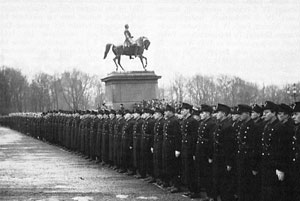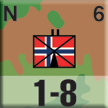Norway�s Shame:
The SS Ski Battalion
By Mike Bennighof, Ph.D.
April 2012
The U.S. Army's 99th Infantry Battalion�s war record
was a source of pride to the Norwegian-American community,
and at the end of the war it was present at the return of
the exiled Norwegian royal court to Oslo.
But Norway also provided volunteers to the other side. Like
all European nations, Norway had a quasi-fascist political
movement before the war, and when the Germans invaded and
occupied the country in 1940, a minority of Norwegians greeted
the move with pleasure. Possibly as many as 50,000 Norwegians
served the Third Reich, most of them in the Waffen-SS.

Norwegian
SS men on parade in Oslo.
Gust Jonassen, a former professor of physical education
and the head of the sports section of the Nasjonal Samling
(the Norwegian Nazi equivalent), proposed that Norway�s
best skiers be recruited for duty alongside the Germans in
the Arctic. Jonassen, a Dane who�d obtained Norwegian
citizenship after marrying a Norwegian, had already volunteered
for and served in the Waffen SS. But like many members of
the sports federation, he preferred the more racist-leaning
wing of the Norwegian SS to the nationalist views of the Nasjonal
Samling. In the summer of 1942 he began recruiting a ski company
for service alongside the 6th
SS Mountain Division Nord, and found plenty of willing
young men.
By September the recruits were transferred to Alsace for training.
Few had military experience, but most were very good on skis.
While infantry training progressed at several locations, officer
candidates, including Jonassen, went through the SS officer
school at Bad T�lz in southern Germany. Jonassen became
its first commander.
The ski company went to Finland in the spring of 1943 and
joined the SS Mountain Division, which assigned it to the
divisional recon battalion. It began long-range ski patrols,
and suffered a number of casualties in small actions including
Jonassen who stepped on a mine in May and was replaced by
Otto Andreas Holmen, a former Norwegian Royal Guard who had
also attended the SS officer school.

Despite the losses, recruits continued to sign up, and in
July the company left Finland for a furlough in Norway (despite
claims of excellence made by veterans and apologists, performance
could not have been very good to warrant withdrawal three
months after entering the lines). In early fall the veterans
went to Oulu, Finland, to expand the unit into a battalion.
To improve its performance, Norwegians from 5th SS Panzer
Grenadier Division �Viking� were transferred into
the unit, and each platoon received a number of German SS
troopers as well. A decorated German SS officer, Richard Benner,
took command of the new battalion but three of the four company
commanders were Norwegians.
Re-training continued through the rest of 1943, and the
battalion re-entered the lines in January 1944. It engaged
in patrols for several months, and in March became involved
in heavy fighting against Soviet probing attacks. Apparently
to improve battalion morale, a Norwegian commander, Frode
Halle, was appointed in April. Halle came from the SS Norge
regiment then serving on the Eastern Front.
On 25 June the brunt of the Soviet offensive in the Kestenga
sector fell on the Norwegian battalion, serving as infantry
now that the snow had melted away. The battalion suffered
heavy casualties and spent several days surrounded, but was
ultimately relieved and withdrew with the rest of the Nord division. The
battalion does not appear to have been placed in the front
lines after the June offensive, but when the Germans began
their withdrawal from Finland in September the Norwegians
were used to screen the movement and they skirmished several
times with the Finnish 11th Division. They also burned down
the Finnish town of Rovaniemi, managing to detonate an ammunition
train and destroy the division�s main hospital.
The Norwegian volunteer unit then went to the Oslo area and
became a security unit, calling its �elite� status
further into question though most of its combat-experienced
men had become casualties by the time the battalion crossed
the border into Norway. In a confusing move, the ski battalion
became the 506th Ski Battalion, while the Nord Division retained
the 506th Panzer Grenadier Battalion and transferred a number
of Norwegians from the ski battalion to the identically-numbered
panzer grenadier unit. The ski battalion clashed with Norwegian
resistance fighters in the mountains of southern Norway, including
a large-scale battle in April, 1945. The panzer grenadier
battalion went to the Western Front with the rest of the division,
where it was destroyed by the Americans.
Just as we�ve done for the American battalion, we�ve
provided a free download
of the SS Norwegian battalion. While the claim has been made
that the unit did not accompany Nord to Alsace because of
a commitment not to deploy its men in the West, it appears
that this low-quality unit simply was not worth the effort
of transporting out of Norway. At a combat strength of 1 it�s
probably over-rated, but the game system doesn�t allow
us to go any lower. The battalion certainly could have been
sent to Alsace.
If the variant is used, the battalion enters as a reinforcement
along with the rest of the division (23 December). If this
unit and the American Norwegian battalion are ever in adjacent
hexes, the moving unit must immediately stop and engage its
opposite number in combat during the upcoming combat phase
(these Norwegians really, really hate each other). Other units
may participate, but the phasing player�s Norwegian
unit must be involved in an attack on the hex occupied by
the other Norwegian unit.
Crush the evil Norwegians: order Alsace 1945 today. |
